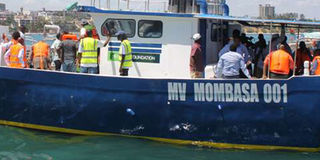Country, locals to gain from Sh20m fishing boat

Employees of Mombasa County government and KCB aboard the MV Mombasa 001 after its launch on November 24, 2016 in Old Town. PHOTO | WACHIRA MWANGI | NATION MEDIA GROUP
What you need to know:
- KCB Foundation Chairperson Catherine Kola said the locally constructed vessel is expected to increase fish harvest in the county to over 40,000 metric tonnes per month.
- The crew will be selling their catch to six companies certified by the European Union to sell to the international market.
The Mombasa government has built a 10-ton modern deep sea fishing vessel that is expected to boost the industry.
Mv Mombasa 001, worth Sh20 million, was constructed in partnership with the Kenya Commercial Bank Foundation and was launched at a function presided over by Governor Hassan Joho at Government Square in Old Port.
The county says the move is in line with its Vision 2035 project. Two others will be added.
"The sea is our natural resource that should benefit our people," Mr Joho said at the launch on Thursday.
"That is why we have partnered with a private entity to ensure we reap maximum benefits from that God-given resource," he added.
Mr Antony Njaramba - Agriculture, Livestock and Fisheries executive - said at least 1,700 fishermen were displaced from their fishing zones by the construction of the SGR project in Changamwe.
He explained that the Beach Management Units (BMUs), which operates like a cooperative society, will manage operations of the vessel by employing the crew.
The crew will be selling their catch internationally through six companies certified by the European Union.
Mr Njaramba also advised the BMUs to decide amicably how the vessel will be used in order to prevent wrangles.
The vessels will assist the fishing communities in exploiting the 200 nautical miles exclusive economic zone (EEZ).
KCB Foundation Chairperson Catherine Kola said the locally constructed vessel is expected to increase fish harvest in the county to over 40,000 metric tonnes per month.
“Through our social investment arm (the foundation) we financed the acquisition of the vessel following a zero per cent interest rate loan of Sh30 million extended to the county government,” she said.
Describing the vessel project as "a game-changer for Kenya’s marine business", Ms Kola noted that the sector remained artisanal and subsistence due to lack of large, fully equipped fishing vessels.
She explained that investing in the marine sector is strategic to the economic growth and this will encourage further investments along the fisheries value chain.
“Our local fishermen only have access to small, non-motorised boats such as outriggers and dhows that cannot go further than the reef or five nautical miles,” she said.
GOOD FUTURE
KCB board director (rtd) General Joseph Kibwana said fish production from the sea has remained constantly low as the country only harvested 9,000 tons compared to Somalia’s 132,000 tons annually.
“Being a stable economy, why should we compare poorly to Somalia which is unstable politically?” he asked, and noted that with the vessel the fishing community can harvest more than 40,000 tons to earn Sh10 million monthly.
The low output has left Kenya susceptible to an increased number of fish imports from China that grew from Sh259 million in 2013 to Sh1 billion in 2015, according to the Kenya National Bureau of Statistics.
The foundation’s Executive Director Jane Mwangi said Kenya was reputed to have some of the best deep-sea fishing spots in the world.
“If these spots are exploited well, they can prove beneficial to our economy. The benefits of this deep sea fishing vessel can help generate 10,000 jobs for the local youth,” she added.
At least, 4,000 youth are poised to benefit directly or indirectly through the commissioning of the deep-sea fishing vessels with plans to increase the fleet to 10 or 14 by the end of next year, she said.
On his part, Governor Joho said the ongoing expansion of the port and standard gauge railway (SGR) have "adversely" affected the marine ecosystem curtailing the breeding grounds of marine life.
The dredging and harvesting of sand used for container terminus at the port, he explained, have completely destroyed different types of fish and livelihoods of the fishing community in all the six sub counties.
“Knowing this has destroyed the lives of people, any port expansion programme should work in tandem with the concerns of its people at heart," he said.
BMUs chairman Kali Khonde welcomed the development, saying it would transform their livelihood along the county’s coastal areas.
Because of the dwindling fish stocks in the nearshore waters, Mr Khonde noted that fishermen using the tradition dugout canoes were finding it difficult to eke out a living, but the vessel will solve that.





